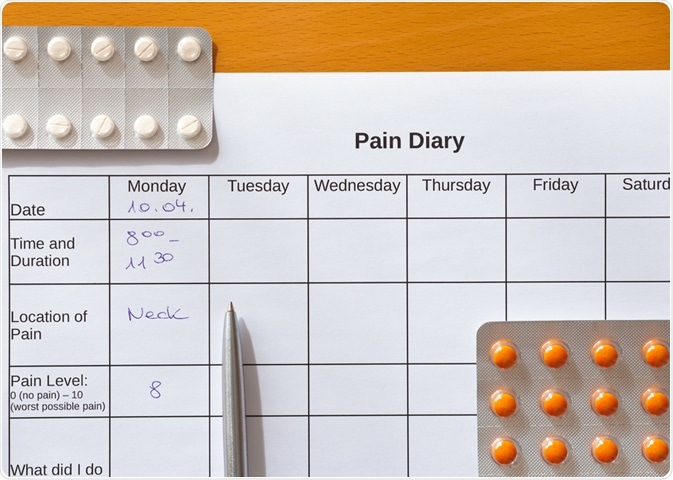Chronic pain can inhibit the quality of life of an individual significantly and establishing patterns between triggers that worsen or lessen pain can be difficult. A pain diary to record these patterns and triggers can be useful to improve control of pain management.
 Image Credit: Agenturfotografin/Shutterstock.com
Image Credit: Agenturfotografin/Shutterstock.com
Benefits of a pain diary
The benefits of a pain diary are clear and it is evident that recording the characteristics and changes of your pain can help to improve overall management. Keeping a pain diary can assist to:
- Establish patterns of pain (e.g. flare ups at certain times, temperatures or after activities)
- Understand effective management techniques (e.g. which therapies provide best pain relief)
- Improve patient-practitioner communication (e.g. more comprehensive information to make therapeutic decisions)
A pain diary can play an instrumental role in the management of chronic pain and help health professionals to gain a comprehensive understanding of the pain experienced by the patient. This helps to avoid gaps in the history, and certain patterns that can be addressed with or without pharmacological intervention can be implemented.
What to record
It is important to record any information that may have an effect on or be associated with the pain. This may include:
- Time and date
- Recent activities and potential triggers
- Changes in medical conditions
- Changes in medications
- Recent pain experienced (location, intensity and duration)
- Effect of any pain relief medications or techniques used
- Emotional or psychological effects of pain
It is not necessary to note every moment that pain is experienced, which could be counterproductive due to increased focus on pain and higher rates of non-adherence.
Instead, it is recommended to make an entry in the diary at certain times throughout the day, often in the morning, midday and before bed. This helps to maintain a regular record of events that provides valuable information about pain and its management. Additionally, it limits the recording of pain to certain times and should not lead to an increased focus on pain at other times of the day.
Describing pain
It is important to be as specific as possible when describing the pain to help establish particular patterns when analyzing the diary later. This includes:
- Location of pain (e.g. lower right side of back)
- Feeling of pain (e.g. sharp, burning, dull, steady, throbbing)
- Severity of scale (e.g. on a scale from 0 to 10)
- Duration and frequency of pain
- Factors that ease pain (e.g. cold compresses, heat, repositioning)
- Exacerbations of pain (e.g. moving, temperatures, time of day)
- Efficacy of pain relieving medications
Using a pain scale to record the intensity of the pain is useful to describe changes of pain in detail and establish patterns in the pain diary.
The intensity is usually recorded on a scale from 0 to 10, with 0 being no pain experienced and 10 being the worst pain imaginable. If the pain diary is being used to record changes at multiple intervals throughout the day, an average can help to give an overall picture of the pain for the day.
In addition to the numerical scale, it can be useful to describe the pain with words such as aching, burning, pounding, shooting, stabbing or throbbing. Describing emotions and psychological effects in words can also be useful.
How to Keep a Pain Diary | Health
References
Further Reading
Last Updated: May 25, 2021